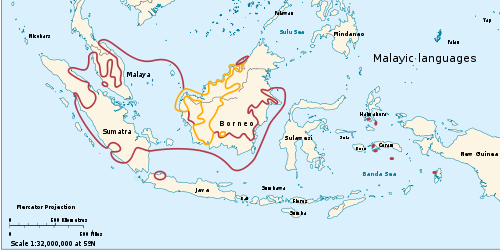- Malayic languages
-
Malayic Geographic
distribution:South East Asia Linguistic classification: Austronesian - Malayo-Polynesian (MP)
- Nuclear MP
- Malayo-Sumbawan
- Malayic
- Malayo-Sumbawan
- Nuclear MP
Subdivisions: Ibanic (Malayic Dayak)
The Malayic languages
The Ibanic languages (orange) are found mostly inland in western Kalimantan, perhaps the homeland of the Malayic peoples, and across Sarawak. The Malayan languages (dark red) range from central Sumatra (their homeland), across Malaya, and throughout coastal Kalimantan. The excluded area in northwest Kalimantan (between the orange and red) is the Land Dayak languages, which are not closely related.The Malayic languages are a branch of the Sunda–Sulawesi languages of the Austronesian family. They include Malay, the national language of Malaysia, Indonesia, and Brunei; Minangkabau in central Sumatra; and Iban in northern Borneo.
It is thought that the homeland of the Malayic languages is in western Borneo, where the Ibanic languages remain. Then Malayan branch represents a secondary dispersal, probably from central Sumatra but possibly also from Borneo.[1]
For some time there was confusion as to the placement of various languages called Dayak; it is now apparent that some of these are Malayic and some are not. The Malayic Dayak languages include Iban; the term Ibanic sometimes applies to the whole or sometimes to a smaller group of Sea Dayak peoples, or Ibanic proper. Other Dayak languages, called Land Dayak, are found in the northwest corner of Kalimantan, between Ibanic and Malayan.
Contents
Languages
- Malayan languages (Minangkabau, Malay)
- Ibanic languages, or Malayic Dayak (Iban and related tongues)
- Banjarese
Although Banjarese, with six million speakers, is commonly considered "local Malay",[2] a 2008 analysis of the Austronesian Basic Vocabulary Database[3] was not able to verify that it is even Malayic. The study was only able to determine with 80% confidence that Banjar is closer to Malayan and Ibanic than it is to other Malayo-Sumbawan languages. It does appear that it is the most divergent Malayic language included in the study.
Classification
Adelaar (1993) classifies the Malayic languages as follows.[4]
- Proto-Malayic
- Iban
- (Main branch)
- Standard Malay
- Minangkabau
- Middle Malay
- Banjarese
- Jakartanese
- Others
Nothofer (1988), however, gives the following classification for the Malayic branch.
- Proto-Malayic
- Rejang
- Embaloh
- Salako
- Iban-Malayan
- Iban
- Malayan
Reconstruction
Phonology
Proto-Malayic has a total of 19 consonants and 4 vowels (Adelaar 1992:102).
Proto-Malayic Consonants Labial Alveolar Palatal Velar Glottal Plosive Voiceless p t[5] c k ʔ Voiced b d ɟ ɡ Nasal m n ɲ ŋ Fricative s h Liquid l ʀ Approximant w y Proto-Malayic Vowels Height Front Central Back Close i /i/ u /u/ Mid ə /ə/ Open a /a/ There are 2 diphthongs:
- *-ay
- *-aw
Morphology
Proto-Malayic syllables are mostly disyllabic and have the following syllable structure (Adelaar 1992:102):
* [C V (N)] [C V (N)] [C V (N)] C V C- Note: C = consonant, V = vowel, N = nasal
Notes and references
- ^ The Austronesians: historical and comparative perspectives. Peter Bellwood, James J. Fox, Darrell Tryon. ANU E Press, 2006. ISBN 1920942858, ISBN 9781920942854
- ^ 'Banjar' at Ethnologue
- ^ Austronesian Basic Vocabulary Database
- ^ Adelaar, K. Alexander. 1993. The Internal Classification of the Malayic Subgroup. Bulletin of the School of Oriental and African Studies, University of London, Vol. 56, No. 3 (1993), pp. 566-581.
- ^ /t/ is listed as dental by Adelaar (1992).
- Adelaar, K. Alexander. 1992. Proto-Malayic: The Reconstruction of its Phonology and Parts of its Lexicon and Morphology. Pacific Linguistics, Series C, no. 119. Canberra: Dept. of Linguistics, Research School of Pacific Studies, the Australian National University.
- Adelaar, K. Alexander. 1993. The Internal Classification of the Malayic Subgroup. Bulletin of the School of Oriental and African Studies, University of London, Vol. 56, No. 3 (1993), pp. 566–581.
- Nothofer, Bernd. 1975. The reconstruction of Proto-Malayo-Javanic. (Verhandelingen van het KITLV, 73.) The Hague: Nijhoff.
- Nothofer, Bernd. 1988. "A discussion of two Austronesian subgroups: Proto-Malay and Proto-Malayic." In Mohd. Thani Ahmad and Zaini Mohamed Zain (eds.) 1988. Rekonstruksi dan cabang-cabang Bahasa Melayu induk, pp. 34–58. Siri monograf sejarah bahasa Melayu. Kuala Lumpur: Dewan Bahasa dan Pustaka.
External links
Categories: - Malayo-Polynesian (MP)
Wikimedia Foundation. 2010.
